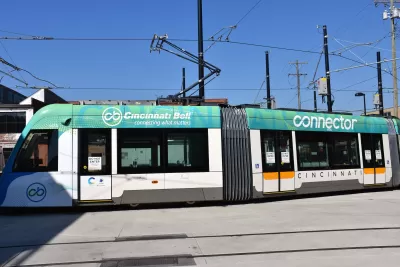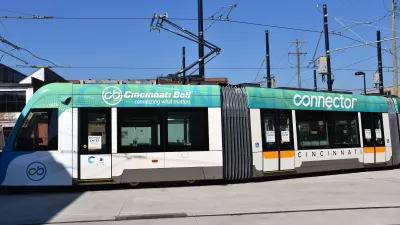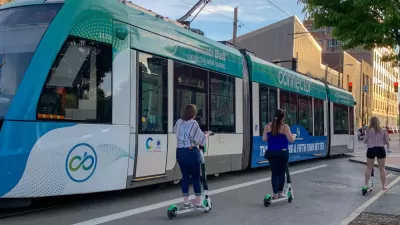A dive into the reach of the Cincinnati Bell Connector's influence on a revitalizing urban neighborhood.

The Cincinnati Business Courier, led by Chris Wetterich and Tom Demeropolis, has published an analysis of the Cincinnati Streetcar, which is actually called the Cincinnati Bell Connector.
The streetcar opened in September following years of controversy, and made the news for the wrong reasons (poor service and sluggish ridership) earlier in December. At the end of the year of the Bell Connector's opning, Wetterich and Demeropolis analyze the real estate impact of the streetcar, recognizing opposing sides to a debate about the drivers of the ongoing revival of the city's Over-the-Rhine neighborhood. Streetcar opponents credit "the city’s generous tax incentive program (which is available in every city neighborhood)" or "the Cincinnati Center City Development Corp. [bringing] urban redevelopment to a large scale." Streetcar supporters "want to attribute nearly everything good that has happened in downtown and Over-the-Rhine to the $148 million project."
Wetterich and Demeropolis inquired with building owners along the streetcar route who had pulled construction permits since 2012 (totaling $160 million in investment) to ask the question: "How much of a factor was the streetcar in your decision to build?" They didn't expect to find receive many straight answers, given the politicized nature of the project, but they were wrong. "Dozens of building owners, developers and lessees were willing to talk with us and be candid about whether the streetcar influenced their decision-making," writes Wetterich.
Unfortunately, the Business Courier's database of findings regarding the Bell Connector's investment impact remains locked by a subscriber paywall, but the free article previewing the work provides testimonials of six of the contacts the two spoke with in gathering the data for the analysis.
FULL STORY: A deeper look at the Courier’s big streetcar project

Alabama: Trump Terminates Settlements for Black Communities Harmed By Raw Sewage
Trump deemed the landmark civil rights agreement “illegal DEI and environmental justice policy.”

Study: Maui’s Plan to Convert Vacation Rentals to Long-Term Housing Could Cause Nearly $1 Billion Economic Loss
The plan would reduce visitor accommodation by 25% resulting in 1,900 jobs lost.

Why Should We Subsidize Public Transportation?
Many public transit agencies face financial stress due to rising costs, declining fare revenue, and declining subsidies. Transit advocates must provide a strong business case for increasing public transit funding.

Paris Bike Boom Leads to Steep Drop in Air Pollution
The French city’s air quality has improved dramatically in the past 20 years, coinciding with a growth in cycling.

Why Housing Costs More to Build in California Than in Texas
Hard costs like labor and materials combined with ‘soft’ costs such as permitting make building in the San Francisco Bay Area almost three times as costly as in Texas cities.

San Diego County Sees a Rise in Urban Coyotes
San Diego County experiences a rise in urban coyotes, as sightings become prevalent throughout its urban neighbourhoods and surrounding areas.
Urban Design for Planners 1: Software Tools
This six-course series explores essential urban design concepts using open source software and equips planners with the tools they need to participate fully in the urban design process.
Planning for Universal Design
Learn the tools for implementing Universal Design in planning regulations.
Smith Gee Studio
Alamo Area Metropolitan Planning Organization
City of Santa Clarita
Institute for Housing and Urban Development Studies (IHS)
City of Grandview
Harvard GSD Executive Education
Toledo-Lucas County Plan Commissions
Salt Lake City
NYU Wagner Graduate School of Public Service




























